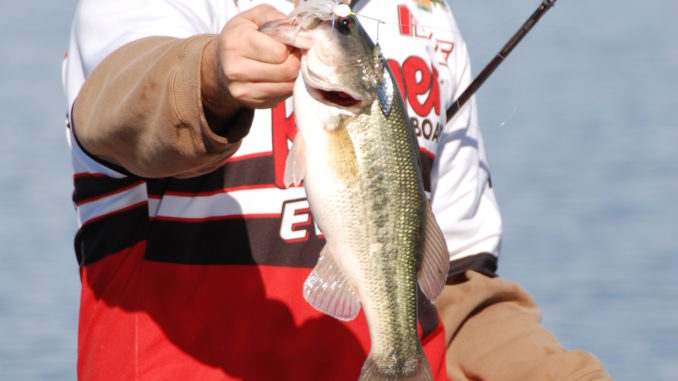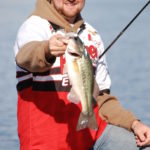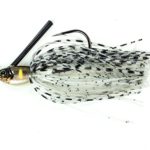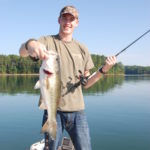
Baitfish are spawning in lakes all over the Carolinas this month, and bass are gorging on them in shallow water. Know where the baitfish birthing room is, and you can blister the bass.
Every bass fisherman in the Carolinas looks forward to the annual spawn, whether it be smallmouth, largemouth or spotted bass. It’s shallow-water fishing at it’s most challenging and often most rewarding.
When the spawn is finished, the consolation is that there is no need to stop targeting spawning fish. The difference is that these fish are not the target species but the prey of black bass species. Most anglers refer to this pattern as the “shad spawn.”
The name is actually as misnomer, because when water temperatures reach the 67 to 70 degrees, a lot more baitfish spawn than just shad.
Bass pro Matt Arey from Shelby, N.C., said that many anglers may be targeting spawning “shad” but are doing it at the wrong time of day and in the wrong places.
“First, you need to decide which baitfish spawn you are fishing,” said Arey, who has qualified for nine FLW Tour championships. “In the Carolinas, a lot of our lakes are herring lakes. When you see guys pulling up to long, shallow points and making casts across the points, it’s the herring pattern. Herring roam those points and spawn in the clay and sand.
“On the other hand, shad — and I’m talking about threadfin shad — may spawn in shallow water, but they want deep water close by, or they may spawn on shallow structure over deep water. Shad also want some kind of structure to rub their eggs on. You can tell you’ve been in the right place for spawning shad if there eggs stuck to the bottom of the boat when you load up. That stuff is like glue.”
Given the option, which spawn does Arey fish when both are underway at the same time? He said it depends on where the bigger fish are holding. As a general rule, on lakes that have an equal number of both prey, herring will stay in the lower third of the lakes, where the terrain is more conducive. Shad are more drawn to upper sections of the lake, where structure and deeper water mix: creek arms, deep docks, bridge pilings and riprap.
“Compare Lake Wylie with Lake Murray. Wylie has more shad, and the shad will spawn all over the lake, but it’s usually near deep water: docks, bridge pilings, deep-water rip rap,” he said. “Lake Murray, on the other hand, is full of herring. That’s your lake for running long points looking for random schools of spawning herring. The shad will be up the lake in the rivers and creeks.”
Arey said South Carolina’s Lake Hartwell and Buggs Island (Kerr) Lake on the North Carolina-Virginia border are good examples of lakes with mixed baitfish species.
Despite the differences between baitfish, Arey and most bass anglers will use lures that imitate shad or herring when their spawns roll around.
“If I’m searching for spawning shad, a 3- or 4-bladed spinnerbait is a good choice in white, white/gray (or) white/blue sparkle with chrome or silver blades,” he said. “If you’re in the right spot, the shad will even hit the lure, thinking it’s a small pod of shad.”
Another of Arey’s favorite choices is a white Lunker Hunt jig. The overall shape matches shad or herring, and his retrieve is either a steady on or you pump the bait back to the boat, depending on how deep he thinks bass are holding.
Arey warned anglers not to depend on either pattern to last very long after dawn breaks.
“All of them spawn at night, and bass will feed on them all night,” he said. “The best bite is going to come the first hour or two of daylight, then it’s going to break up and you need to go find another pattern.”
While he’s targeting the same fish that just a few hours earlier were eating shad or herring like Krispy Kreme’s “Hot/Fresh/Now” doughnut sign was on, those fish tend to stay in the same general areas.
“Herring fish are spooky,” he said. “We’re talking about fish that are holding on long, shallow points with little or no cover in generally clear water. In broad daylight, those fish get finicky, plus, there is a lot of pressure on them.”
Arey’s preference is to target bass that are eating shad, fish that fall back to more-consistent patterns once the buffet line closes. He thinks it’s a little easier to tempt those fish into eating since their surroundings provide more security.
“You’re always going to have those fish that pull back under a good boat dock once the day gets on,” he said. “And even though the bass spawn is over, there will be a good number of bass left in the shallows as fry guarders.
Arey admits that shad and herring aren’t the only fish spawning in shallow water in late spring. He won’t overlook the opportunity to catch a big, resident bass that is hanging out on the edge of a bream bed waiting for something to get out of line.
“The difference is that every bass in the lake is looking for shad to eat during the spawn, and only a certain number of bass will patrol bream beds,” said Arey. “Those tend to be the resident bass in that creek or cove, but those fish also tend to be bigger. Sometimes the biggest bass will target bluegill.”
Knowing where to look for bass often boils down to a lesson in fisheries biology. With so many species of fish trying to reproduce at the same time, it’s often hard to know where to cast. Scott Lamprecht, a biologist with the S.C. Department of Natural Resources, offered to help shed some light on what’s on the menu this month.
“Far and wide across the Carolinas, I would have to say threadfin shad are the No. 1 prey species for largemouth bass,” he said. “Threadfins are the most important forage species for a lot of fish in this area.”
Lamprecht said it is common for threadfin shad to spawn several times over the course of the spring, summer, and fall. The determining factors are water temperature and the photoperiod — the amount of daylight — that triggers spawning.
Lamprecht said blueback herring are also important forage for bass, but not all lakes contain blueback herring, which are considered river herring along with alewives, which are more common in northern states.
“You’ll find herring spawning over sandy bottoms, but they also prefer vegetation for spawning,” he said. “It’s not unusual to see them in squirming around in pockets of aquatic weeds.
Bluebacks are more commonly found as landlocked species, although they do come in from the ocean in coastal rivers,” Lamprecht said. “Lake Norman and some of the Catawba chain lakes also have resident populations of alewives.”
Gizzard shad are targeted by bass at certain times of the year; Lamprecht said fall is the time when gizzard shad have the most to fear from largemouths.
“Largemouths will target yearling gizzards pretty hard, but those fish are not the spawners that you’ll see spawning in May and June,” he said. “But gizzards frequent shallow water most of the time, so I would not rule gizzards out as a bass prey.”
Lamprecht lumps the final two prey species into two groups. The first are minnow species that range from members of the shiner and chub families, and the second are young of the year sunfish: crappie, bluegill and perch.
“Shiners like vertical structure to spawn on, similar to shad,” said Lamprecht. “Some minnow species — fathead minnows come to mind — will spawn under structure like logs or the underside of boat docks.”







Be the first to comment